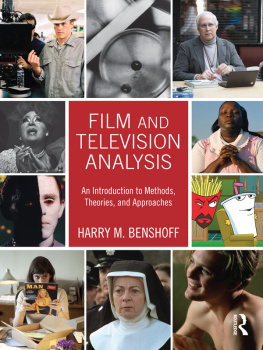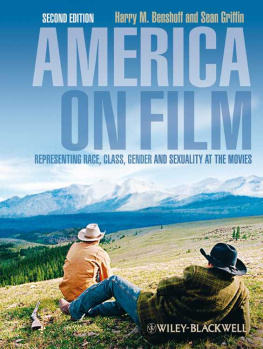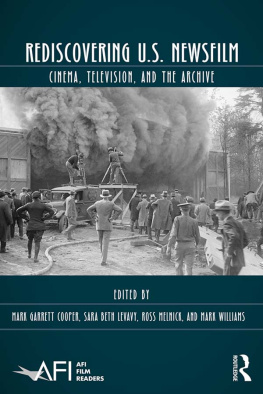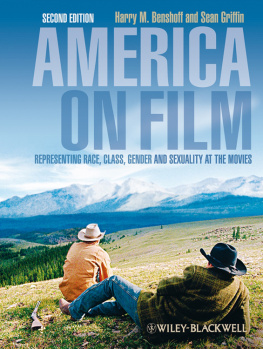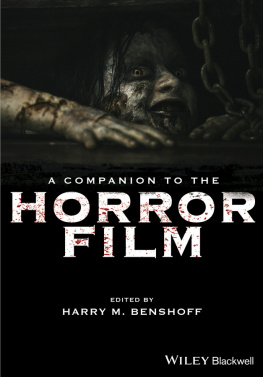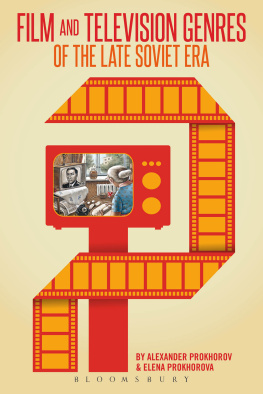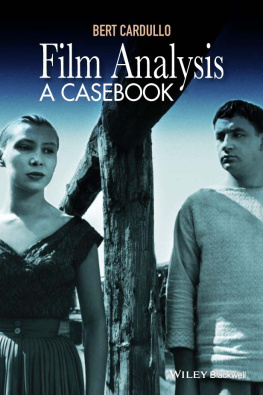Harry M. Benshoff - Film and Television Analysis: An Introduction to Methods, Theories, and Approaches
Here you can read online Harry M. Benshoff - Film and Television Analysis: An Introduction to Methods, Theories, and Approaches full text of the book (entire story) in english for free. Download pdf and epub, get meaning, cover and reviews about this ebook. year: 2016, publisher: Taylor and Francis, genre: Romance novel. Description of the work, (preface) as well as reviews are available. Best literature library LitArk.com created for fans of good reading and offers a wide selection of genres:
Romance novel
Science fiction
Adventure
Detective
Science
History
Home and family
Prose
Art
Politics
Computer
Non-fiction
Religion
Business
Children
Humor
Choose a favorite category and find really read worthwhile books. Enjoy immersion in the world of imagination, feel the emotions of the characters or learn something new for yourself, make an fascinating discovery.
- Book:Film and Television Analysis: An Introduction to Methods, Theories, and Approaches
- Author:
- Publisher:Taylor and Francis
- Genre:
- Year:2016
- Rating:4 / 5
- Favourites:Add to favourites
- Your mark:
- 80
- 1
- 2
- 3
- 4
- 5
Film and Television Analysis: An Introduction to Methods, Theories, and Approaches: summary, description and annotation
We offer to read an annotation, description, summary or preface (depends on what the author of the book "Film and Television Analysis: An Introduction to Methods, Theories, and Approaches" wrote himself). If you haven't found the necessary information about the book — write in the comments, we will try to find it.
Harry M. Benshoff: author's other books
Who wrote Film and Television Analysis: An Introduction to Methods, Theories, and Approaches? Find out the surname, the name of the author of the book and a list of all author's works by series.
Film and Television Analysis: An Introduction to Methods, Theories, and Approaches — read online for free the complete book (whole text) full work
Below is the text of the book, divided by pages. System saving the place of the last page read, allows you to conveniently read the book "Film and Television Analysis: An Introduction to Methods, Theories, and Approaches" online for free, without having to search again every time where you left off. Put a bookmark, and you can go to the page where you finished reading at any time.
Font size:
Interval:
Bookmark:
First published 2016
by Routledge
2 Park Square, Milton Park, Abingdon, Oxon OX14 4RN
and by Routledge
711 Third Avenue, New York, NY 10017
Routledge is an imprint of the Taylor & Francis Group, an informa business
2016 Harry M. Benshoff
The right of Harry M. Benshoff to be identified as author of this work has been asserted by him in accordance with sections 77 and 78 of the Copyright, Designs and Patents Act 1988.
All rights reserved. No part of this book may be reprinted or reproduced or utilised in any form or by any electronic, mechanical, or other means, now known or hereafter invented, including photocopying and recording, or in any information storage or retrieval system, without permission in writing from the publishers.
Trademark notice: Product or corporate names may be trademarks or registered trademarks, and are used only for identification and explanation without intent to infringe.
British Library Cataloguing-in-Publication Data
A catalogue record for this book is available from the British Library
Library of Congress Cataloging-in-Publication Data
Benshoff, Harry M., 1963
Film and television analysis : an introduction to methods, theories, and approaches / Harry M.
Benshoff.
pages cm
Includes bibliographical references and index.
1. Film criticism. 2. Television criticism. I. Title.
PN1995.B347 2015
791.43015--dc23
2015007551
ISBN: 978-0-415-67480-5 (hbk)
ISBN: 978-0-415-67481-2 (pbk)
ISBN: 978-0-203-12996-8 (ebk)
Typeset in 10/12pt Bembo MT Pro
by Fakenham Prepress Solutions, Fakenham, Norfolk NR21 8NN

This book is designed to introduce basic qualitative approaches to the study of film and television, primarily to undergraduate students. It grew out of a need, in the department of Media Arts at the University of North Texas, for an intermediate level critical-cultural studies class in methodologies, one that could take its place in the curriculum between basic introductory classes (usually offered at the freshman level) and more advanced topics classes, offered at the junior and senior levels. The perceived need for such a class arose from the fact that many of our upper division topics classes regularly assigned books and essays that dealt with concepts that were more theoretically advanced than the materials found in our basic freshman introductory class. Thus RTVF 3610, Film and Television Analysis was created to fill the gap, in order to ease the transition between simpler and more difficult classes. RTVF 3610 was developed by myself and several colleagues over the course of many years, and it has since become a prerequisite for students wanting to enroll in advanced topics classes that may assign (for example) original essays by Laura Mulvey, Peter Wollen, D. A. Miller, and/or Linda Williams. All of our critical-cultural faculty agree that the class has been a success: students are much more prepared to engage with writings that incorporate psychoanalytic, feminist, and/or poststructuralist ideas (among others) once they have been introduced to them in a class (or a book) such as this one.
This book also had input from the 2010 Society for Cinema Studies conference, during a workshop I created and chaired entitled Teaching Film and Television Theory to Undergraduate Students. The panelists and the audience had an invigorating discussion on the topic, but what became quickly apparent to me was that very few people in the room even agreed on what the term theory meant, let alone how it might best be incorporated into an undergraduate curriculum. Some people expressed the view that theoryhowever defined was too difficult for undergraduates, while others proudly announced that their students were required to take a year-long sequence of classes wherein they read Gilles Deleuze's Cinema 1: The Movement-Image and Cinema 2: The Time-Image . I was reminded of a time when I was a teaching assistant for the Introduction to Film class at the University of Southern California, and one of my ambitious colleagues handed out Laura Mulvey's Visual Pleasure and Narrative Cinema to first-year students. At the time, I wondered what the students would take from the essay, considering it had not been discussed in lecture and that most of them probably had very little exposure to basic psychoanalytic concepts. Surely some sort of primer that introduced and explained the essay's basic theoretical concepts could have helped students in that situationhelped them parse the essay and grasp its meanings. Such a primer is exactly what this book aims to be.
In writing this volume, I have had to confront a fear that it (and I) might be accused of dumbing down and/or misrepresenting the complex and frequently brilliant ideas expressed by previous writers and thinkers on the subjects of film and television analysis. Why not just throw students into the deep end of the theoretical pool (so to speak) and see if they learn to swim? Certainly, there are some universities where highly prepared students can and do encounter Gilles Deleuze or Laura Mulvey in highly productive ways (most likely in smaller seminar settings). However, I also realize there are many other institutions (like mine) where that is not a practical approach to teaching film and television studies. At UNT, we process hundreds of majors a year, and those students are interested in vastly different subject areasfrom fictional filmmaking to TV studio production, and from media management to sports broadcasting. In short, I feel that programs like ours can and do benefit from an approach that is represented by this book, and the class it was derived from, RTVF 3610. Even students who do not go on to take advanced critical-cultural studies classes are exposed to the basic ideas of the discipline, learning to approach film and television from a variety of different critical and analytical perspectives. Those who do pursue further education in critical-cultural studies gain a helpful grounding in the field's central and historically important concepts, a stepping stone that helps them process the more complex concepts and readings explored in later classes.
That said, I think there are many different ways a book like this can and could be useful, based upon varying student abilities and the shape of institutional curricula. At UNT, the class this book is designed upon is taught each long semester to approximately ninety junior-level students. Scantron tests are administered to gauge whether or not the students are learning the concepts at hand, and a number of short writing exercises, designed to allow the students to apply those concepts, are also assigned throughout the semester. (Similarly, questions for discussion are also featured throughout this textbook.) On the other hand, this book might also be ideal in smaller group settings in conjunction with a selection of important primary essays, many of which are increasingly available in excellent anthologies such as Braudy and Cohen's Film Theory and Criticism or Corrigan, White, and Mazaj's Critical Visions in Film Theory . This book is not meant to replace volumes such as those, but rather supplement and introduce some of the ideas they contain, so that when students do encounter the important primary literature of film and television studies, they are prepared to engage with it, and not merely be baffled by it.
The choice of what is included in this volume and how it is presented may seem somewhat idiosyncratic, but this volume is based upon the perceived needs of the students at UNT, as well as my own personal interests and emphases in the area of film and television studies. One of the first things that will become apparent is that I view this as a book of theor ies and method s , not a book about Theoryhowever one might define that. In class I often liken this approach to speed dating: students meet a new method or approach every week. In so doing, they are not required to date or marry any one theory, but they are required to learn the basic concepts and values of any given approach. This book also stresses the historical development of film and television theories, and in so doing further underlines the point that there is not one grand theory for explaining all aspects of film and television, but rather an ever-changing and evolving set of ideas that people have used over the yearsand continue to useto approach and explore the various meanings of film and television texts. I am deeply indebted to two previous textbooks that I feel share these goals (and that I continue to use in my own classes): Robert C. Allen's Channels of Discourse, Reassembled and Joanne Hollows and Mark Jancovich's Approaches to Popular Film . If this volume comes anywhere near the elegance and usefulness of those books, it will be because their clarity and pedagogical brilliance have been my inspiration and my guide.
Font size:
Interval:
Bookmark:
Similar books «Film and Television Analysis: An Introduction to Methods, Theories, and Approaches»
Look at similar books to Film and Television Analysis: An Introduction to Methods, Theories, and Approaches. We have selected literature similar in name and meaning in the hope of providing readers with more options to find new, interesting, not yet read works.
Discussion, reviews of the book Film and Television Analysis: An Introduction to Methods, Theories, and Approaches and just readers' own opinions. Leave your comments, write what you think about the work, its meaning or the main characters. Specify what exactly you liked and what you didn't like, and why you think so.

